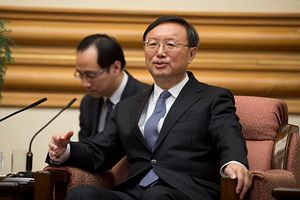On Tuesday, Yang Jiechi, the head of the Central Foreign Affairs Commission of the Chinese Communist Party, paid a short visit to Myanmar as part of a globe-spanning tour that will also take him to Greece and Spain. Coming almost eight months after President Xi Jinping’s state visit to Myanmar in January, Yang’s stop in Naypyidaw was aimed at shoring up key areas of bilateral cooperation ahead of Myanmar’s upcoming elections on November 8, which the ruling National League for Democracy (NLD) is widely expected to win.
In separate meetings with Myanmar’s State Counselor and de facto leader Aung San Suu Kyi, and its de jure President Win Myint, Yang sought assurances about the implementation of key Belt and Road Initiative (BRI) infrastructure projects. In particular, he focused on the slew of BRI projects gathered under the smaller umbrella of the China-Myanmar Economic Corridor (CMEC), a planned overland network of highways, railways, pipelines, and industrial zones intended to link China’s Yunnan province to Myanmar’s coast on the Bay of Bengal.
While the CMEC is a recent initiative, its fundamental goals have been present in Chinese official thinking since the mid-1980s when strategists in Beijing first began to eye Myanmar as a potential overland outlet for Chinese exports, and later as an alternative overland route for Middle Eastern oil imports that would reduce its heavy reliance on the narrow Straits of Malacca. Among its various components, CMEC includes proposed rail and road connections between Myanmar and China to complement the oil and natural gas pipelines that were completed in 2013 and 2014, as well as three free trade zones along the two countries’ shared border. CMEC’s showcase project is the planned deep-sea port and accompanying Special Economic Zone at Kyaukphyu on Myanmar’s western coast, where the existing oil and gas pipelines terminate on the Bay of Bengal.
In advancing these aims, Beijing has been greatly aided by the recent alienation of Aung San Suu Kyi’s government from the Western democracies that once championed her struggle against military dictatorship. Relations have gone downhill since mid-2017, when Myanmar’s army, or Tatmadaw, responded to scattered attacks by Rohingya militants by torching villages and driving more than 700,000 civilians over the border into Bangladesh, actions which the United Nations’ human rights chief has described as “acts of appalling barbarity” and possible “acts of genocide.”
Claiming a position of “non-interference” over the Rohingya issue, China has since taken the opportunity to regain strategic ground lost following Myanmar’s remarkable opening to the West in 2011 and 2012, when the government suspended several costly and controversial Chinese infrastructure projects. The CMEC was first proposed by Chinese officials in November 2017, just three months after the military’s “clearance operations” against the Rohingya, and then signed into existence the following September.
Yet despite welcoming Chinese support over the Rohingya crisis, Myanmar has displayed considerable caution in the face of Beijing’s pushy economic diplomacy. Concerned about taking on too much Chinese debt, in August 2018 it successfully negotiated a down-scaling of the Kyaukphyu port deal, reducing its gargantuan $7.3 billion price tag to a more affordable $1.3 billion. A few months later, the Myanmar government created a Steering Committee for Implementation of BRI, chaired by State Counselor Aung San Suu Kyi, to review Chinese megaprojects and ensure that they serve Myanmar’s interests.
In general, progress on the various CMEC projects has been much slower than what Beijing would like. Indeed, one of the main goals of President Xi Jinping’s two-day visit in January was to ensure that Myanmar picked up the pace. During his trip, which saw the signing of 33 minor bilateral agreements relating to various aspects of the BRI and CMEC, Xi called for both nations to deepen “result-oriented Belt and Road cooperation” and move from “the conceptual stage to concrete planning and implementation.” It was a none-too-subtle request for Myanmar to stop dragging its feet.
This year’s diplomatic engagements reveal both the reach and limits of Chinese influence in Myanmar. While Beijing’s promise of “non-interference” on the Rohingya question ensures it permanent access to the chambers of power in Naypyidaw, suspicion of China remains entrenched throughout the ranks of Myanmar’s government and military, to say nothing of the public at large. While Yang’s visit this week was intended to ensure that progress on vital infrastructure projects, however slow, continues in the run-up and aftermath of Myanmar’s upcoming election, it is also a recognition of further complications to come.

































